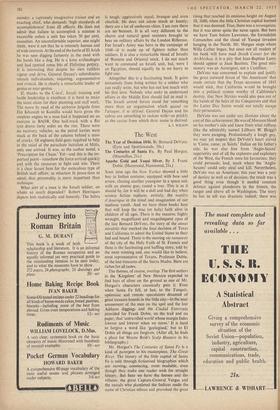The West
The Year of Decision 1846. By Bernard DeVoto. (Eyre and Spottiswoode, 50s.) The Centuries of Santa Fe. By Paul Horgan. (Macmillan, 21s.) Apache Gold and Yaqui Silver. By J. Frank Dobie. (Hammond, Hammond, 21s.)
SOME time ago the New Yorker showed a little boy in Indian costume, equipped with bow and arrow, chasing another youngster in a space suit, with an atomic gun, round a tree. This is as it should be, for it will be a dull and bad day when science fiction replaces, entirely, the matiere d'Amerique in the mind and imagination of our studious youth. And we have three books here that will keep the true (or holy) faith alive in children of all ages. There is the massive, highly wrought, magnificent and magniloquent opus of the late Bernard DeVoto, the story of the alums mirabilis that marked the final decision of Texas and California to admit the United States to their bed and board, There is the moving vie romance(' of the city of the Holy Faith of St. Francis and there is the fascinating and baffling story, told by the most winning and, one would like to believe, most representative of Texans, Professor Dobie, of the lost treasures of the Sierra Madre, Here are riches for all tastes.
The themes, of course, overlap. The first settlers in the 'Kingdom' of New Mexico expected to find bars of silver on the ground as one of Mr. Horgan's characters caustically puts it. Even when Santa Fe fell, at last, to the Yanquis, optimistic and remote speculators dreamed of great treasure hoards in the little city—to the sour amusement of the men on the spot and the lost Addams diggings and the Ciudad Enterrada provided for Frank Dobie, on the trail and on paper, that 'untravelled world whose margin fades forever and forever when we move.' It is hard to forgive a word like `geologised,' but to El Dobie all things are forgiven. (After all, he finds a place for Mayne Reid's Scalp Hunters in his bibliography.) Mr. Horgan's The Centuries of Santa Fe is a kind of parergon to his masterpiece, The. G real River. The history of the little capital of Santa Fe is told through fictionised biographies which are moving, convincing, most readable, even though they make one reader wish for straight history. But here we have the heroes and the villains; the great Captain-General Vargas and the rascals who plundered the Indians made the name of Christian odious and provoked the great rising that reached its ominous height on August 18, 1680, when the little Christian capital learned that it was doomed. True, there was a reConquista, but it was never quite the same again. But here we have Taos before Lawrence, the formidable Comanches and the cloud of Yanqui invasion hanging in the North. Mr. Horgan stops where Willa Cather began, but since not all readers of his book will have read Death Comes for the Archbishop, it is a pity that Jean-Baptiste Lamy should appear as Juan Bautista. The great mis- sionary was an Auvergnat, not a Castillian.
DeVoto was concerned to explain and justify the great outward thrust of 'the Americans' that made certain that the Texas accession of 1845 would stick, that California would be brought into a political system worthy of California's destiny, that New Mexico would also pass out of the hands of the heirs of the Conquerors and that the Latter Day Saints would not totally escape their persecutors.
DeVoto was not under any illusions about the cost of this achievement. He was of Mormon blood on his mother's side and knew from what ruffians (like the admirably named Lillburn W. Bloggs) they were escaping. Professionally a tough guy, we may yet suspect that DeVoto's heart stirred to 'Come, come, ye Saints.' Italian on his father's side, he was also free from 'Anglo-Saxon' superiority and of all the explorers and exploiters of the West, the French were his favourites; they could persuade, lead, teach where the 'Anglo- Saxons' could only steal and kill. Nevertheless, DeVoto was an American; this year was a year of destiny as well as of decision; the result was a good thing even though it needed constant defence against plunderers in the forests, the ranges and above all in Washington. The story he has to tell was dramatic indeed; there was heroic war and less heroic plundering; there were disasters, cannibalism. There were critics of the great achievement like Theodore Parker and flamboyant exploiters of it like John Charles Fremont. There were dangers by flood and field, and Bernard DeVoto could have charmed a flock of Desdemonits with this tale. There were enemies to be put down, too; superior historians who refused to go over the trail, to appreciate the magic of maps and geological surveys. Over these DeVoto swept like a Comanche raiding party. It is great fun—and good history.
D. W. BROGAN



































 Previous page
Previous page